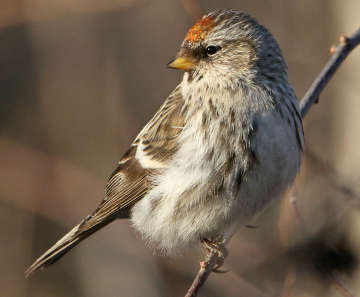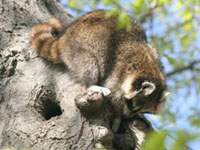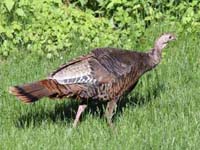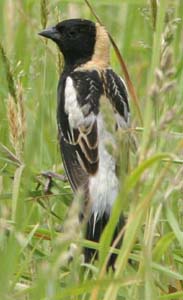|
Recap of Dr. Tom French’s Annual Meeting Talk
 Tom French
Tom French
Did you know that we now have almost every species that was here at the time of
European settlement? From ravens, eagles, and turkeys to moose, bears, beavers, and
fishers, many of these species had nearly or completely disappeared from
Massachusetts, but they are now making a comeback, according to Dr. Tom French,
Assistant Director for the Natural Heritage and Endangered Species Program at
MassWildlife, who spoke at WCLT’s 2013 Annual Meeting last June. His own special
area of work is endangered species, but he talked extensively about the
rollercoaster history of wildlife in Massachusetts.
What causes species to become endangered? Loss of habitat, Tom emphasized, is
the most common cause of endangerment here in Massachusetts—and in the world.
The historical context in Massachusetts
In 1620, with the arrival of the Pilgrims, European settlers began sending wild
plants and animals back to Europe. For example, they sent sassafras from Cape Cod
for use as root medicine. Early European settlers went to Canada for walrus, which
were killed for oil and ivory until they were wiped out.
The 1700s were a time of pioneer expansion. In Massachusetts, forests were cut
down to create farm and pasture land.
Deforestation peaked between 1830 and 1860. Only 2,000 acres were left uncut.
The town of Florida in northwestern Massachusetts is one of the few towns where old
growth forest still remains today.
From the Civil War period onward, people left Massachusetts for the Midwest and
did not return. As agriculture was abandoned, forests began to regrow and have been
doing so ever since, although development has continued to claim land.
Fate of wildlife species
Certain species were persecuted because they were viewed as threats to people or
their livestock: bobcats, great horned owls, ravens, and timber rattlesnakes. A
bounty system rewarded people for killing these predators and turning in evidence,
for example, by bringing a dead animal’s foot to town hall.

Common redpoll (photo courtesy of Garry Kessler)
Birds had no protection until the Migratory Bird Treaty Act of 1918. Prior to
that, some species became extinct due to overhunting, such as the passenger pigeon
(1917) and the Eskimo curlew. Native songbirds are now protected all the time.
Hunting of game birds is regulated by defined hunting seasons, limits on the
numbers taken, and restrictions on the weapons allowed.
Today, wolf and mountain lion populations are long gone from Massachusetts,
although occasional individuals show up. An example was a wolf that was killing
lambs in Shelburne, MA in 2008.
What animals are doing well in Massachusetts?
 Raccoon fishing for food in a tree
Raccoon fishing for food in a tree
(photo courtesy of Garry
Kessler)
Tom reported that raccoons, skunks, crows, and painted turtles are resilient
species that are doing well. Also, red foxes and cottontail rabbits actually
benefit from living near people because they find food nearby and get protection
from predators. Beaver are now “everywhere,” as are white-tailed deer.
Black bear populations are expanding in Massachusetts by about 8 percent
per year. Most black bears are in Worcester County and westward.
“They’re practically the mascot of Northampton, MA,” Tom said. A black bear even
appeared on Cape Cod in 2012. These bears like to eat garbage and the black oil
sunflower seeds that people put in bird feeders. There are about 60 to 65 home
invasions by bears per year in Massachusetts.
Moose are expanding in Massachusetts. They had been absent since the
1700s, but rare sightings began to occur in the 1970s. Now they number about 1,100,
with most in northern Worcester County. No moose hunting is allowed in
Massachusetts. Young moose that are dispersing come here because they tend to go
where there are other moose.
Due to their large size and long legs, moose are a danger on the roads, with one
human fatality per 100 car collisions. When hit, moose tend to have their legs
knocked out from under them and then fall heavily on the car. Moose are susceptible
to brain damage from a brain worm that also infects—but doesn’t harm—white-tailed
deer.
Fishers (a member of the weasel family) disappeared from the state in the
early 1800s as the trees disappeared but are now common in most of the state. They
returned with the trees.
Coyotes came to Massachusetts from farther west with the creation of an
open-land patchwork of forests and fields. The first specimen dates from 1957. They
are now everywhere (except Nantucket and Martha’s Vineyard), numbering about
10,000. About 500 per year are taken by hunters. Tom noted that coyotes become
aggressive only if people feed them. He said they’ll kill dogs for territorial
reasons and cats for food.
 Wild turkey
(photo courtesy of Garry
Kessler)
Wild turkey
(photo courtesy of Garry
Kessler)
Wild turkeys are now common statewide and are often used as a symbol of
the state of Massachusetts. They had been extirpated here by 1851 and first began
to return in 1972.
Canada geese became common after the Migratory Bird Treaty Act. Before
that, some people used to keep Canada geese as decoys to attract migrating geese to
hunt, but they released them when such hunting was no longer allowed. This led to
the establishment of resident populations of Canada geese in the state.
Bald eagles, peregrine falcons, and ravens have been helped to begin
their recoveries in Massachusetts. The last historic bald eagle nest was in 1905,
but the first restoration nest in the state was in 1989. There are now 42 pairs of
bald eagles in the state, with many chicks raised in wild nests.
Peregrine falcons were harmed by DDT, but the ban of DDT in the 1970s set
stage for their restoration. Peregrine falcons now nest here on cliffs and ledges,
such as those at Mt. Tom, and on buildings, as in Worcester.
Certain seagulls, namely herring gulls and great black-backed gulls, have
been helped by the purchase of islands for them to nest on, after they had been
wiped out in the area.
Challenges
Rabies is a “wild card” because any mammal (including marsupials such as
opossums) can get the disease. Bats, raccoons, and skunks typically get the raccoon
strain of rabies. Other animals that are occasionally infected include woodchucks,
foxes, deer, beaver, coyotes, and bobcats.
Managing people and how they act around wildlife is an ongoing challenge.
More people than ever live close to wildlife these days. Some wild animals become
quite used to humans and venture into neighborhoods and yards, even in the daytime,
but people need to remember that they are wild, not tame.
Protecting rare species and their habitats
In his work at MassWildlife, Tom’s focus is rare species, such as arethusa
(a rare orchid), Hessel’s hairstreak (a rare butterfly that may inhabit
Westborough’s Cedar Swamp), and marbled salamanders.
The following tools are available for the protection of rare species and,
importantly, their habitat.
 Bobolink, a grassland bird
Bobolink, a grassland bird
(photo courtesy of Garry
Kessler)
- Land protection is important. MassWildlife owns about 200,000 acres.
The Department of Conservation and Recreation (DCR) also owns or manages about
300,000 acres.
- Habitat management helps to preserve certain habitats; for example,
through burns and mowing to maintain grassland habitat, or other management for
grassland birds.
- Ecological restoration includes invasive plant removal (targeting,
for example, purple loosestrife and non-native phragmites in wetlands), as well
as prescribed burns in fire-adapted habitats.
- Education is important in reaching kids early, especially these days
when kids are not getting outside very much. Tom commended MassAudubon for its
educational programs.
- Research provides information for further efforts.
- Regulations and regulatory review are important. Key Massachusetts
laws include the Massachusetts Endangered Species Act, Massachusetts Wetlands
Protection Act, and the Massachusetts Environmental Policy Act. Of the 2,500
projects that NHESP reviews each year, 77% are found to need no change in order
to conform to the regulations.
Back to top
|